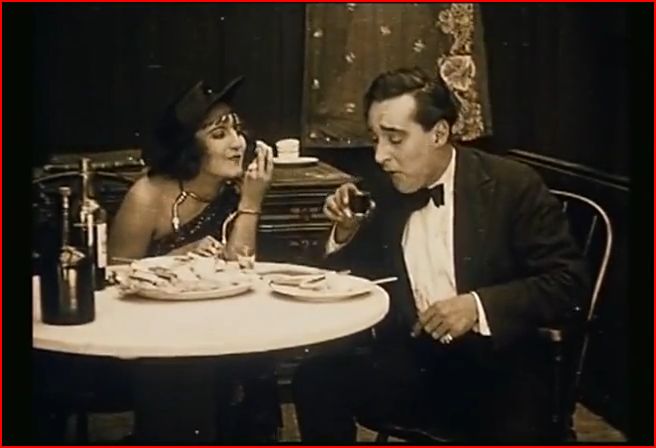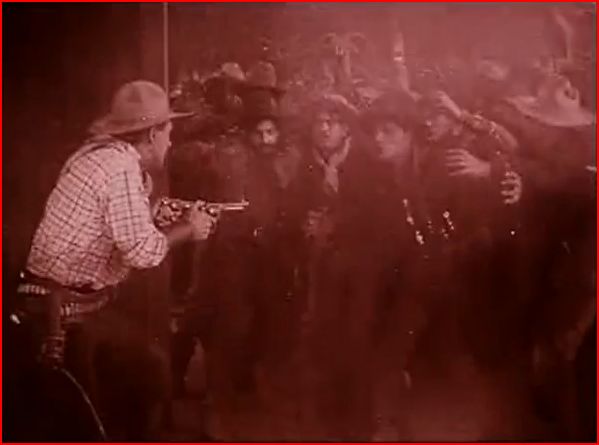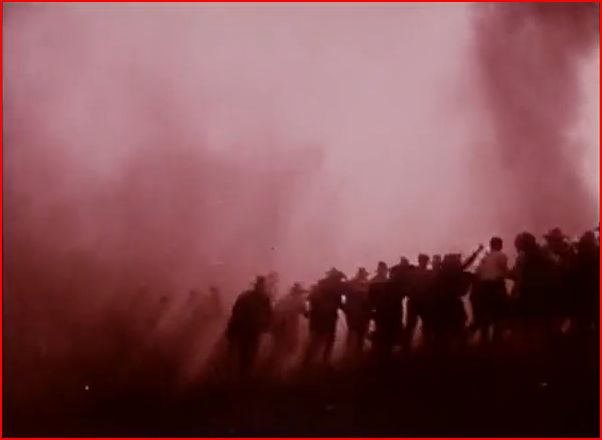 Western movies have been with us since 1903's The Great Train Robbery, if not before. Edwin S. Porter's short subject is probably still perceived as "the first film to tell a story," however untrue the claim is. But if westerns go all the way back to the beginnings of narrative cinema, Hell's Hinges is arguably the first western that really shows us what the genre was capable of, the first to indulge in apocalyptic violence and vengeance in a truly picturesque, cinematic fashion. Made a year after D. W. Griffith wrote history with lightning, Hell's Hinges is the Birth of a Nation of westerns. The violence is white-on-white but it portrays no less of a kulturkampf than Griffith's racist epic -- and the absence of a race element may make the culture element more stark and alarming. In 1916 the U.S. was near the high tide of the campaign for Prohibition. That campaign converges with the Ku Klux Klan revival allegedly sparked by Griffith's film as part of a nativist defense of a traditional Protestant culture deemed authentically American. Hell's Hinges portrays a war on Christianity on the 19th century frontier, in which, presumably, sympathetic audiences recognized a shadow of the war on their traditional values waged in their own days by the defenders of the saloon, the sabbath breakers, the suffragists, etc. And in William S. Hart that audience saw the wrath of God.
Western movies have been with us since 1903's The Great Train Robbery, if not before. Edwin S. Porter's short subject is probably still perceived as "the first film to tell a story," however untrue the claim is. But if westerns go all the way back to the beginnings of narrative cinema, Hell's Hinges is arguably the first western that really shows us what the genre was capable of, the first to indulge in apocalyptic violence and vengeance in a truly picturesque, cinematic fashion. Made a year after D. W. Griffith wrote history with lightning, Hell's Hinges is the Birth of a Nation of westerns. The violence is white-on-white but it portrays no less of a kulturkampf than Griffith's racist epic -- and the absence of a race element may make the culture element more stark and alarming. In 1916 the U.S. was near the high tide of the campaign for Prohibition. That campaign converges with the Ku Klux Klan revival allegedly sparked by Griffith's film as part of a nativist defense of a traditional Protestant culture deemed authentically American. Hell's Hinges portrays a war on Christianity on the 19th century frontier, in which, presumably, sympathetic audiences recognized a shadow of the war on their traditional values waged in their own days by the defenders of the saloon, the sabbath breakers, the suffragists, etc. And in William S. Hart that audience saw the wrath of God.
Why does the frontier need taming? I'm not asking about the line separating settler from Indian; the problem in so many westerns is that the settlers themselves need taming. Aren't those settlers of authentic American stock? Aren't they Christians when they set out? Presumably so, but something happens on the frontier that helps define the western. Coming to tame the frontier, the settlers end up needing to be tamed. That's the situation in the town called Hell's Hinges when the film gets there, and the situation repeats itself in miniature.

Rev. Robert Henley (Jack Standing) is sent from New York to restore religion to the frontier town. In a prologue, the film has already told us that Henley is a flawed preacher, more interested in preaching as a performance for admiring ladies than in winning souls. We're also told that his sister Faith (Clara Williams) who comes to Hell's Hinges with him is a better Christian than he is. Woman is the vanguard of civilization in many westerns, whether as the archetypal schoolmarm or as an evangelist like Faith. Where Robert performs Christianity, Faith lives it. It's something you can see in every part of her demeanor, if you have the sensitivity or sensibility to recognize it. Miraculously, someone in town does recognize it. Blaze Tracy (Hart) is just one of the guys in Hell's Hinges until Faith shows up. Something about him responds to something about her. Pop fiction of the time described it as some sort of race instinct to worship and defend female purity. In simpler terms, Blaze is smitten, so he's going to defend the Henleys against the hostility of most of the town, allying himself with the "petticoat brigade," which despite the feminizing label includes a handful of righteous bearded patriarchs, all of them longing for old time preaching, but not getting it from the Rev.

Instead, Hell's Hinges corrupts the preacher. Fearful of the potential influence of religion on business, the town saloon keeper Silk Miller (Alfred Hollingsworth) has Dolly, one of his dance hall girls (Louise Glaum) seduce Robert Henley. It doesn't take much: one drink and the Rev. is in Reefer Madness land, practically. Dolly detains him all Saturday night so he misses his Sunday sermon, the congregation finding the two passed out together. An instant alky, Robert is later goaded into joining a mob in burning his own church. A gun battle breaks out between the mob and the congregation, and Robert is killed in the crossfire.

This happens while Blaze is riding out to fetch a doctor for Robert. Now that his time has been wasted, Blaze is plenty mad. I'm probably understating this. Never mind that the greater offense in his eyes was probably making Faith cry. Whatever the provocation, his anger is unfathomable, yet he is poker-faced in his determination as he marches toward the camera and into town. The violence against the church in this picture has already been somewhat startling -- did things really get this bad in the Old West? -- but what follows is stunning. Not if we measure by body count, since I think Blaze kills no more than three people. But as a matter of scale Hell's Hinges sets the standard for disproportionate response to offense. To avenge Robert Henley and his church, Blaze -- his very name is foreshadowing -- burns the town to the ground.

Charles Swickard is the credited director of this Thomas H. Ince production, but one Clifford Smith and Hart himself shared in the direction. The big question is who directed the last reel, because that director is a master. Working with cinematographer Joseph August, who would do exemplary work into the 1940s, the director stages a minor Armageddon, at once dangerously authentic -- Hart is literally playing with fire -- and precociously expressionist as fire and smoke turn the town into an abstraction of disaster and panic. From the startling (for 1916) overhead shot as Blaze cows a crowd and shoots out a lamp to the serendipitous lens flare as he walks past an explosion without flinching -- setting another precedent -- the film's climax is virtuoso filmmaking that still impresses after almost a century.




Blaze Tracy is Hart's definitive "good bad man" and the ancestor of Clint Eastwood's William Munny among others who practically become bad good men. Blaze's wrath is terrible to behold, the more so as he becomes less a laughing mocker like his erstwhile peers and more a grim-faced avenger. In his fiery apotheosis Hart achieves a paradoxical charismatic expressionlessness. We see him snarl a little as he confronts the saloon crowd, but he remains glacially unmoved by the destruction he perpetrates and the horror surrounding him, not even afraid for himself as he takes his time striding through the holocaust. Across the years, you'll recognize him as a type you still see in movies today. Much about Hell's Hinges may seem obsolete or quaint, but Hart could be a star now with this performance, because he helped define a certain kind of stardom, just as this film defined a certain kind of western.
* * *
Do you have an hour or so to kill? Then have a look at Hell's Hinges in full. MantisCinema uploaded this 63 minute version to YouTube.
Hell's Hinges is the Birth of a Nation of westerns.
ReplyDeleteWell I will definitely watch this today, and applaud you for researching and informing this rarity with such scholarship and enthusiasm! This is the first time I have heard of this film, much less have laid eyes on such a comprehensive assessment. And yes I can see the reasons why you'd compare it in an epic sense with Griffiths' film. A major find here!
You've convinced me I need to rewatch this. The only time I've seen this was about a decade if not more ago, and I don't recall liking it that much.
ReplyDeleteSamuel,
ReplyDeleteThis one will place high on my ballot when I finalize it. I watched this a few months ago and believe it's a true masterpiece.
Hells Hinges is still 1000 times better than anything the British film industry can produce NOW ! ! !.
ReplyDelete